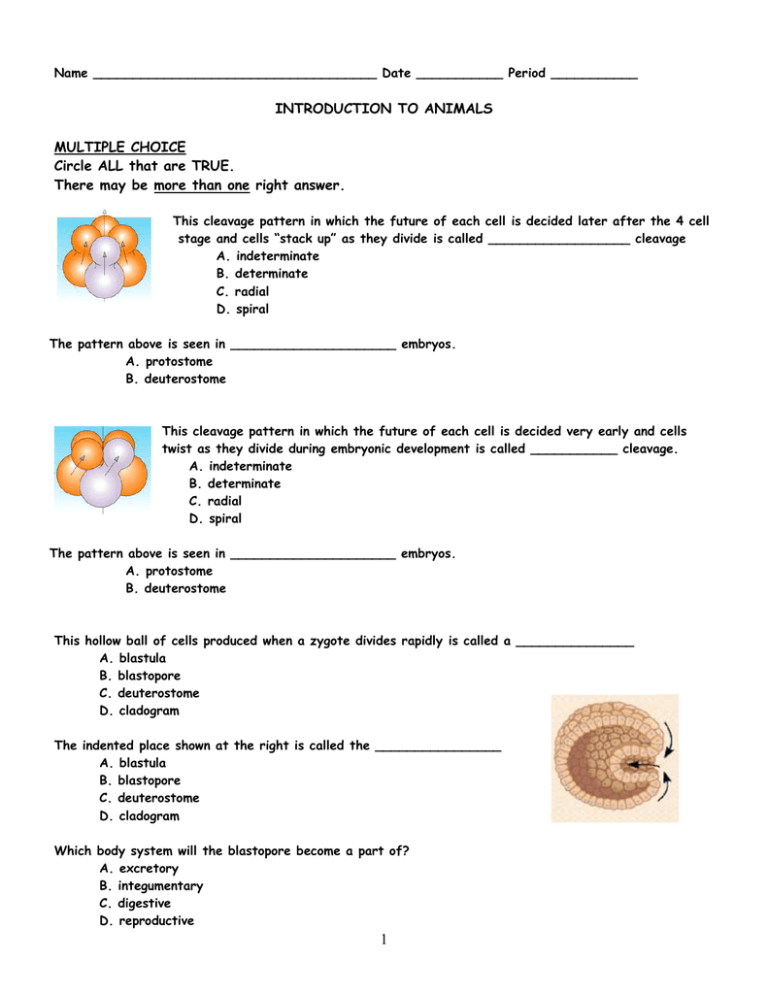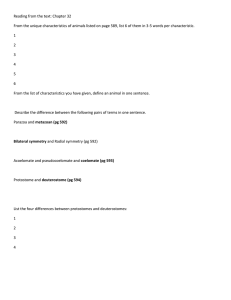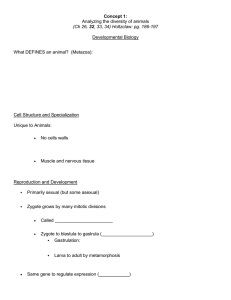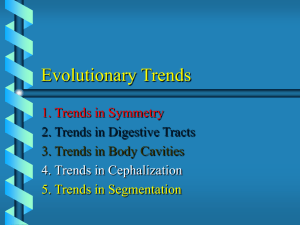INTRODUCTION TO ANIMALS MULTIPLE CHOICE Circle ALL that are TRUE.
advertisement

Name ____________________________________ Date ___________ Period ___________ INTRODUCTION TO ANIMALS MULTIPLE CHOICE Circle ALL that are TRUE. There may be more than one right answer. This cleavage pattern in which the future of each cell is decided later after the 4 cell stage and cells “stack up” as they divide is called __________________ cleavage A. indeterminate B. determinate C. radial D. spiral The pattern above is seen in _____________________ embryos. A. protostome B. deuterostome This cleavage pattern in which the future of each cell is decided very early and cells twist as they divide during embryonic development is called ___________ cleavage. A. indeterminate B. determinate C. radial D. spiral The pattern above is seen in _____________________ embryos. A. protostome B. deuterostome This hollow ball of cells produced when a zygote divides rapidly is called a _______________ A. blastula B. blastopore C. deuterostome D. cladogram The indented place shown at the right is called the ________________ A. blastula B. blastopore C. deuterostome D. cladogram Which body system will the blastopore become a part of? A. excretory B. integumentary C. digestive D. reproductive 1 In all protostome embryos, the blastopore will become the __________________. A. mouth B. anus In all deuterostome embryos, the blastopore will become the ___________________. A. mouth B. anus The diagram at the left shows an organism with _______________ development. A. direct B. indirect Which of the following is/are functions of a coelom? A. Provide space for food to be digested and nutrients absorbed B. Provides space for body organs to develop C. Provides place for nutrients and gases to circulate if there are no blood vessels D. Fluid in coelom can support animal if there is no skeleton (hydrostatic skeleton) Echinoderms, like starfish, are the only group that shows both of the following characteristics. A. invertebrates B. vertebrates C. protostomes D. deuterostomes * * * * * * * * * * * * * * * TRUE or FALSE Circle T if the statement is TRUE. Circle F if the statement is FALSE. If the statement is false, make corrections to the underlined word to make it TRUE T F Humans show indirect development. T F Removing cells from an early protostome embryo will produce an organism with missing parts. T F All vertebrates are protostomes and all invertebrates are deuterostomes except Echinoderms. T F All animals have a TWO opening digestive system, like the one shown below. 2 SHORT ANSWER: List 7 characteristics shared by all animals: _____________________________________ ______________________________________ _____________________________________ ______________________________________ _____________________________________ ______________________________________ ______________________________________ * * * * * * * * * * * * * * * Identify the kind of symmetry shown: ________________________ __________________________ ________________________ Which kind of symmetry do most animals (INCLUDING HUMANS) have? _________________________ * * * * * * * * * * * * MATCHING Match the kind of waste with the correct description. USE D for DIGESTIVE WASTE USE N for NITROGEN WASTE ______ Made by body cells when proteins are broken down ______ Includes urea, uric acid, and ammonia ______ Handled by the digestive system 3 * * * ______ Remains after nutrients are absorbed from broken down food ______ Handled by the excretory system ______ Also called FECES * * * * * * * * * * * * * * * MATCH THE FORM OF NITROGEN WASTE WITH ITS DESCRIPTION UREA AMMONIA URIC ACID ______________________ MOST TOXIC (POISONOUS) and requires the most water to dilute ______________________ LEAST TOXIC and requires the least water to dilute ______________________ Made from ammonia by the liver and excreted by the kidneys in humans ______________________ Most often excreted by organisms that live in water ______________________ Excreted by reptiles, birds, and many insects ______________________ Excreted by mammals, amphibians, and some fish * * * * * * * * * * * * * * * Name the 3 germ layers found in most animal embryos. ________________________ ________________________ ________________________ From which of these three germ layers do MUSCLE cells form? ______________________ From which of these three germ layers does the skin form? _________________________ From which of these three germ layers does the nervous system form? _________________________ From which of these three germ layers does the stomach & intestines form? _____________________ 4 Color the 3 kinds of COELOMS labeled below then answer the questions about coeloms. (Endoderm =Yellow Mesoderm = red Ectoderm = blue) ACOELOMATE (NO space) PSEUDOCOELOMATE COELOM “true coelom” MATCH THE KIND OF COELOM ABOVE WITH ITS DESCRIPTION You can used them more than once Use A for ACOELOM P for PSEUDOCOELOM C for TRUE COELOM _____ Has a body cavity with mesoderm lining the body wall but not around the gut _____ Has endoderm, mesoderm, and ectoderm, but no body cavity (space) _____ Has a body cavity lined on BOTH sides by mesoderm _____ type of coelom found in flatworms _____ type of coelom found in round worms _____ type of coelom found in segmented worms _____ type of coelom found in all animals higher than worms on the phylogenetic tree _____ type of coelom found in nematodes _____ type of coelom found in all vertebrates _____ type of coelom in planarians What is the advantage of having a “true coelom” as compared to being acoelomate or pseudocoelomate? 5 WHAT IS THE VOCAB WORD? ______________________________ Animals without a backbone ______________________________ Animals with a backbone ______________________________ Joining of sperm and egg inside the female’s body ______________________________ Joining of sperm and egg outside the female’s body ______________________________ Type of circulatory system in which blood circulates enclosed INSIDE of blood vessels ______________________________ Type of circulatory system in which blood circulates loose inside the body cavity and tissue spaces and is NOT enclosed in vessels ______________________________ Concentration of nervous tissue and sense organs in the anterior end of an organism ______________________________ Organism with spiral determinate cleavage in which the embryonic blastopore becomes the mouth ______________________________ Organism with radial indeterminate cleavage in which the embryonic blastopore becomes the anus ______________________________ The body cavity or space around the internal organs in an animal ______________________________ Indented in place in a blastula that becomes the mouth in protostomes and the anus in deuterostomes ______________________________ Type of development in which organisms must undergo metamorphosis to change into their adult form ______________________________ Type of development in which organisms hatch or are born looking like smaller versions of the adult form ______________________________ Maintaining the balance of water & ions in the body 6 USE WORDS FROM THE WORD BANK TO LABEL THE DIAGRAM: ANTERIOR POSTERIOR DORSAL VENTRAL __________________ _______________ ____________________ __________________ Does this organism show CEPHALIZATION? YES NO Explain your answer. What type of SYMMETRY does this organism have? ________________________ * * * * * * * * * * * * * * * MATCH THE BODY SYSTEM WITH ITS FUNCTION. (You can use them more than once!) __________________________ Breaks down food and absorbs the nutrients __________________________ Osmoregulation (maintain the balance of ions and water) __________________________ Produces offspring __________________________ Covers and protects the outside of an organism’s body __________________________ Removal of digestive waste (feces) __________________________ Removal of nitrogen waste (urea, uric acid, or ammonia) ___________________________ Exchanges oxygen and carbon dioxide gases with the environment ___________________________ Circulates fluid containing nutrients, gases, and nitrogen waste throughout body __________________________ Receives information from the environment and sends response signals __________________________ Provides a sturdy framework that supports the organism and protects some body organs 7 __________________________ ___________________________ Moves the body itself or moves substances in the body (pushes food through the digestive system OR blood through blood vessels) Produces hormones that control other organs & body systems Using the terms provided below, complete the concept map showing the features of animals. bilateral symmetry external primary tissue layers blastula formation heterotrophy radial symmetry body plan mobility sexual reproduction diploidy multicellularity tissues 8 Answer the following questions. 1. Animals in which the embryonic blastopore becomes the ANUS are called ____________________. 2. This organism shows ___________ symmetry. 3. Identify the type of coelom shown in this picture. Acoelomate Pseudocoelomate True coelom 4. Which body system deals with osmoregulation and getting rid of nitrogen waste made by body cells? _______________________ 5. This indented area seen in developing animal embryos is called the _____________________. 6. It will develop into the ________________ system. 7. Type of circulatory system in which blood is carried inside of blood vessels. _________ 8. Body parts (like a human arm and bird wing) which have the same embryonic origin are called _________________ structures. (analogous or Homologous) 9 9. Are the limbs shown in the diagram homologous or analogous? 10. Are these organisms related? Explain why or why not. 11. Nitrogen waste from body cells can be removed in several different chemical forms. Name one. 12. Name the PHYLUM of invertebrates which is thought to be more like vertebrates than other invertebrates because of the way their embryos develop. 13. a. Organisms whose young hatch as an immature larva, which undergoes metamorphosis to change into an adult, show __________ development. 13. b. What type of metamorphosis is this --- complete or incomplete? 14. Give an example of an animal that is a deuterostome. 15. A eukaryotic, multicelled, heterotroph with specialized cells that contain DNA with the ability to move and reproduce is called a(n) ________________. 16. Animals without backbones are called _________________ 17. Name the 3 germ layers that form in developing animal embryos. 18. The concentration of nervous tissue and sensory organs in the anterior end of an animal is called __________________ 10 19. The arrow is pointing to the _____________ surface of this animal. anterior posterior ventral dorsal 20. If you remove cells from or split the blastula in an early _____________ embryo, the resulting organism will be missing body parts and will not survive. Protostome Deuterostome 21. Maintaining the balance of water and ions in the body is called _________________. Multiple Choice. Only one answer is correct. _____ 1. The study of animals is A. Botany B. Zoology C. Geology _____2. The body system that is concerned with the animal's movement, its shape, and protecting its organs is A. Reproductive B. Circulatory C. Muscular/Skeletal _____3. The body system responsible for making more of these organisms is A. Reproductive B. Circulatory C. Muscular/Skeletal _____4. The system responsible for breaking down food for cells is A. Excretory B. Digestive C. Respiratory _____5. The body system responsible for gas exchange (oxygen and carbon dioxide) is A. Digestive B. Circulatory C. respiratory _____6. The body system responsible for getting rid of nitrogen wastes is A. Excretory B. Digestive C. Respiratory 11 _____7. The body system responsible for taking in information and reacting to it is A. Reproductive B. Endocrine C. Nervous _____8. The system that distributes food and gases throughout an animal's body is A. Digestive B. Circulatory C. respiratory _____9. Whenever an animal's body lacks a specific form A. Asymmetry B. Radial symmetry C. Bilateral symmetry _____10. With this there is a center to the animal's body from which limbs or arms come out from as if from a circle, much like the spokes on a bicycle wheel A. Asymmetry B. Radial symmetry C. Bilateral symmetry _____11. This means that an animal has two sides that are almost exactly the same on each side. Thus if you drew a line down the middle of the animal's body, one side would be a mirror image of the other side. A. Asymmetry B. Radial symmetry C. Bilateral symmetry _____12. Which of these is NOT true of animals A. Animals take in carbon dioxide and give off oxygen B. Animals move more freely than plants C. Animal cells do not have a cell wall Modified from: http://brookings.k12.sd.us 12







